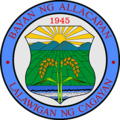Allacapan | |
|---|---|
| Municipality of Allacapan | |
 Sunset view in Barangay Labben | |
 Interactive map of Allacapan | |
| Coordinates: 18°13′37″N121°33′20″E / 18.226967°N 121.555583°E | |
| Country | Philippines |
| Region | Cagayan Valley |
| Province | Cagayan |
| District | 2nd district |
| Barangays | 27 (see Barangays) |
| Government | |
| • Type | Sangguniang Bayan |
| • Mayor | Yvonne Florida |
| • Vice Mayor | Jay-Ar Florida |
| • Representative | Samantha Louise V. Alfonso |
| • Electorate | 22,193 voters (2025) |
| Area | |
• Total | 306.80 km2 (118.46 sq mi) |
| Elevation | 30 m (98 ft) |
| Highest elevation | 135 m (443 ft) |
| Lowest elevation | 1 m (3.3 ft) |
| Population (2024 census) [3] | |
• Total | 35,946 |
| • Density | 117.16/km2 (303.45/sq mi) |
| • Households | 8,389 |
| Economy | |
| • Income class | 3rd municipal income class |
| • Poverty incidence | 13.35 |
| • Revenue | ₱ 250.8 million (2022) |
| • Assets | ₱ 661.1 million (2022) |
| • Expenditure | ₱ 192 million (2022) |
| • Liabilities | ₱ 141.1 million (2022) |
| Service provider | |
| • Electricity | Cagayan 2 Electric Cooperative (CAGELCO 2) |
| Time zone | UTC+8 (PST) |
| ZIP code | 3523 |
| PSGC | |
| IDD : area code | +63 (0)78 |
| Native languages | Ilocano Ibanag Tagalog |
Allacapan, officially the Municipality of Allacapan (Ibanag: Ili nat Allacapan; Ilocano : Ili ti Allacapan; Filipino : Bayan ng Allacapan), is a municipality in the province of Cagayan, Philippines. According to the 2024 census, it has a population of 35,946 people. [5]


